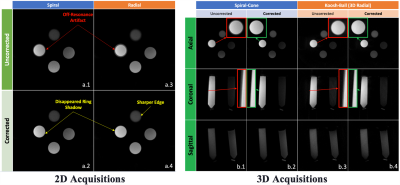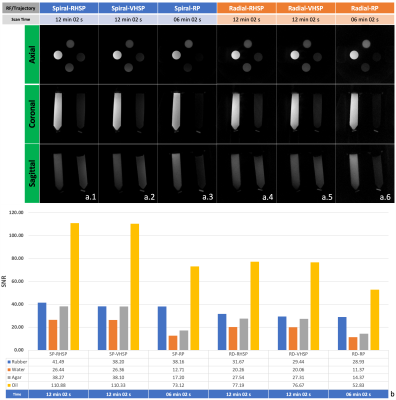Lumeng Cui1, Emily J. McWalter1,2, Gerald R. Moran3, and Niranjan Venugopal4
1Division of Biomedical Engineering, University of Saskatchewan, Saskatoon, SK, Canada, 2Department of Mechanical Engineering, University of Saskatchewan, Saskatoon, SK, Canada, 3Research Collaboration Manager, Siemens Healthcare Limited, Oakville, ON, Canada, 4Department of Radiology, University of Manitoba, Winnipeg, MB, Canada
1Division of Biomedical Engineering, University of Saskatchewan, Saskatoon, SK, Canada, 2Department of Mechanical Engineering, University of Saskatchewan, Saskatoon, SK, Canada, 3Research Collaboration Manager, Siemens Healthcare Limited, Oakville, ON, Canada, 4Department of Radiology, University of Manitoba, Winnipeg, MB, Canada
The UTE sequence developed allows for 2D and 3D acquisitions, choice of trajectory, off-resonance artifact reduction, RF pulse choice and long T2 species suppression, as such it is a flexible tool that can be used and optimized for many UTE applications.

Figure 2. The off-resonance artifact improved with the deblurring algorithm in both the 2D Spiral (a.1-2) and the 2D Radial (a.3-4) acquisitions. The off-resonance artifact improved with the deblurring algorithm in both the 3D Spiral-cone (b.1-2) and 3D Radial (“Koosh-Ball”) (b.3-4) acquisitions. The red and green enlargements in figure b highlight the comparison before and after the correction in 3D. Beginning from the top and going clockwise, the vials contain rubber, water, agar and oil.

Figure 4. Comparison of 3D radial and spiral trajectories among the regular half-Sinc pulse (RHSP) excitation, VERSE-modified half-Sinc pulse (VHSP) excitation, and the rectangular pulse (RP) excitation with matching scan parameters (a.1-6). SNR of the rubber (short T2 material) was generally higher for the spiral trajectories as compared to the radial trajectories. SP-spiral; and RD-radial. Beginning from the top and going clockwise, the vials contain rubber, water, agar and oil.